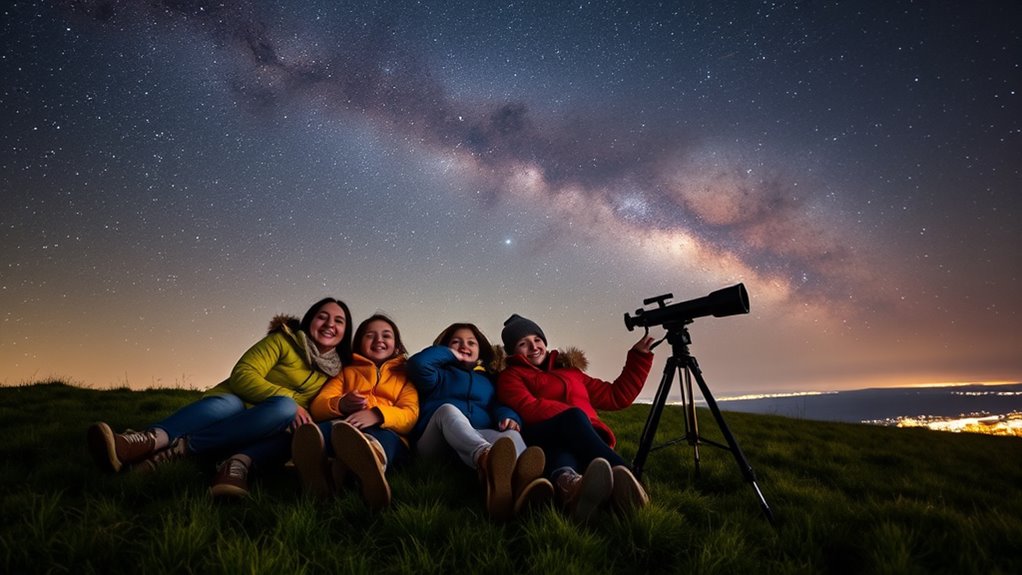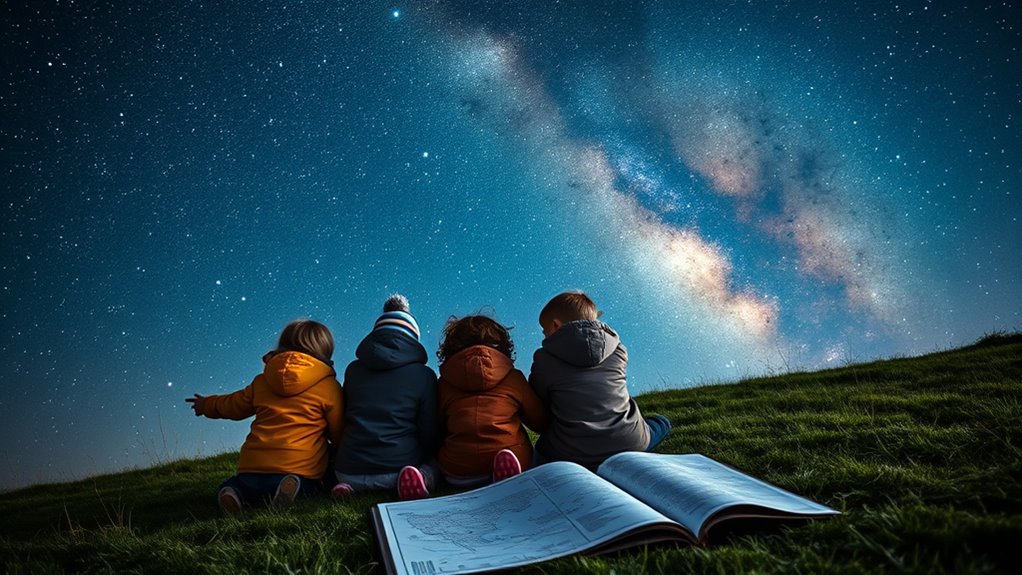Stargazing with kids is a fun way to explore the night sky and learn celestial navigation. Start by using a star chart or a stargazing app to identify prominent constellations like Orion or the Big Dipper. Find a dark, clear spot away from city lights for the best view. Practice recognizing pattern movements and seasonal changes to deepen your experience. Keep exploring, because the more you discover, the more magical your nighttime adventures become.
Key Takeaways
- Use star charts or stargazing apps to identify constellations and navigate the night sky with kids.
- Start in dark, clear outdoor areas away from city lights for optimal star visibility.
- Begin by spotting prominent constellations like Orion or the Big Dipper to serve as sky reference points.
- Observe star movement over multiple nights to reinforce understanding of celestial navigation and seasonal changes.
- Incorporate safety gear and patience to make learning fun and ensure a safe, engaging stargazing experience.

Stargazing is a rewarding hobby that lets you explore the night sky and discover its many wonders. When you start, you’ll quickly realize that learning to navigate the stars isn’t just about admiring their beauty; it’s about understanding the stories they tell and how to find your way using them. One of the first skills you can develop is celestial navigation, which involves using prominent stars and constellations to guide you. This can be especially fun when you’re with kids, as it turns stargazing into an interactive adventure. Recognizing constellations is the foundation of this skill. Instead of just looking up at a random scattering of stars, you’ll learn to identify familiar shapes and patterns. These patterns serve as signposts in the night sky, making it easier to orient yourself.
To get started, you’ll want a star chart or a stargazing app that shows the current positions of constellations. Once you have a good reference, head outdoors on a clear night, ideally away from city lights that can drown out faint stars. Begin by locating the most prominent constellation, like Orion or the Big Dipper, which are usually easy to spot even for beginners. When you recognize these, you can use them as anchors to find other nearby constellations. Kids will enjoy the challenge of matching what they see to the pictures on the star chart, turning stargazing into a game of discovery. As you practice, you’ll start noticing the movement of stars over the course of the night, which reinforces your understanding of celestial navigation. Additionally, understanding the importance of proper Bike gear, such as reflective clothing or lights, can make your nighttime adventures safer and more enjoyable, especially in low-light conditions.
Learning constellation recognition also helps you understand the seasonal shifts in the sky. Different constellations appear at different times of the year, so you can plan your stargazing trips accordingly. For children, this becomes a fun way to connect the sky with the passage of seasons, making the experience both educational and magical. Remember, patience is key. It might take a few outings to get comfortable recognizing constellations and using them for navigation, but each session adds to your confidence. With practice, you’ll be able to point out stars and constellations quickly, even in low-light conditions. This skill not only makes your stargazing more meaningful but also transforms it into an engaging activity where you and your kids can feel like explorers charting a map written in the stars.
Frequently Asked Questions
What Equipment Is Essential for Beginner Stargazing?
When you’re starting out, the essential equipment includes a good telescope selection suited for beginners and star chart usage to navigate the night sky. A simple, portable telescope helps you see planets and some stars clearly, while star charts or apps guide you in identifying constellations. You don’t need fancy gear—just a basic setup, patience, and a clear night to enjoy the stars and learn more about the universe.
When Is the Best Time of Year to Observe Stars?
Ever wonder when you should go stargazing? The best time is during a new moon or when moon phases minimize moonlight, making stars more visible. Clear, dark skies are essential, so avoid nights with high light pollution. Generally, fall and winter offer longer, darker nights, but check local weather and moon phases to pick the perfect time. Planning around these factors guarantees you’ll enjoy a spectacular view of the night sky.
How Can I Teach Kids About Constellations Effectively?
You can teach kids about constellations effectively by sharing stellar stories that capture their imagination. Use simple language and relate constellations to familiar shapes or animals. Incorporate fun activities like constellation crafts, where they create their own star maps or models. Encourage them to look up at the night sky and identify patterns, making learning interactive and memorable. This hands-on approach helps kids connect with the stars and sparks their curiosity.
Are There Safety Tips for Nighttime Outdoor Activities?
Did you know that a simple outdoor night adventure can turn into a safe, memorable experience? Always supervise your children closely and make certain they wear appropriate clothing for the weather to stay warm and dry. Keep flashlights handy, stay on familiar paths, and watch out for uneven ground. These safety tips help you enjoy the night sky with confidence, making your outdoor adventure both fun and secure for everyone involved.
How Do Weather Conditions Affect Stargazing Success?
Weather conditions markedly impact your stargazing success. You’ll want clear skies, so avoid nights with heavy cloud cover, which block your view of stars. Light pollution from city lights can also diminish visibility, making it harder to see faint stars. Check weather forecasts before heading out, and choose a dark, open area away from artificial lights for the best experience. Clear, dark nights give you a much better chance of spotting constellations.
Conclusion
As you wrap up your stargazing adventure, remember that even the most experienced skywatchers started with a curious eye and a little patience. Every night under the stars is a new chance to discover wonders and share special moments with your kids. Don’t worry if things don’t go perfectly—sometimes the best memories come from just enjoying the mystery and magic of the night. Keep looking up, and let the universe surprise you.










